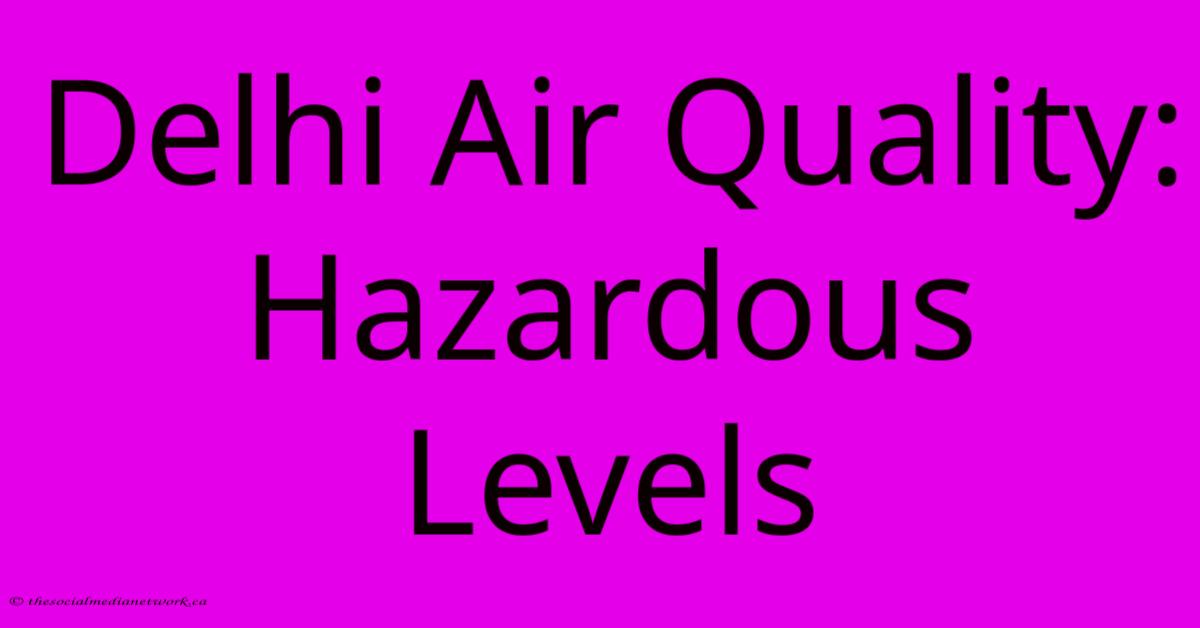Delhi Air Quality: Hazardous Levels

Discover more detailed and exciting information on our website. Click the link below to start your adventure: Visit Best Website meltwatermedia.ca. Don't miss out!
Table of Contents
Delhi Air Quality: Hazardous Levels and What You Can Do
Delhi's air quality frequently plunges to hazardous levels, a critical public health concern demanding immediate attention. This alarming situation necessitates understanding the causes, consequences, and potential solutions. This article delves into the complexities of Delhi's air pollution crisis, exploring the contributing factors and offering practical steps individuals can take to mitigate the impact on their health and the environment.
The Causes of Delhi's Hazardous Air: A Multifaceted Problem
Delhi's poor air quality is a result of a complex interplay of factors, making it a challenging issue to address. Key contributors include:
1. Vehicular Emissions: A Major Culprit
The sheer volume of vehicles on Delhi's roads, coupled with a high percentage of older, poorly maintained vehicles, contributes significantly to the high levels of pollutants like particulate matter (PM2.5 and PM10) and nitrogen oxides. Traffic congestion exacerbates the problem, leading to prolonged exposure to exhaust fumes.
2. Industrial Emissions: A Persistent Threat
Industrial activities within and around Delhi release a substantial amount of pollutants into the atmosphere. While regulations exist, enforcement remains a challenge, leading to continued emissions from various industries. Lack of stringent monitoring and penalties further contributes to this problem.
3. Construction Activities: Dust and Debris
Rapid urbanization and construction activities generate large amounts of dust and debris, which are easily airborne and contribute significantly to particulate matter pollution. Poor dust control measures on construction sites worsen the situation.
4. Seasonal Factors: Agricultural Burning and Weather Patterns
Seasonal factors play a crucial role. The burning of agricultural stubble in neighboring states during harvest season releases massive quantities of pollutants into the air, often causing a dramatic spike in Delhi's air quality index (AQI). Unfavorable weather patterns, such as stagnant air and temperature inversions, trap pollutants close to the ground, exacerbating the problem.
5. Waste Burning: An Uncontrolled Menace
Open burning of waste, a common practice in many parts of Delhi, adds to the already polluted air. This releases harmful toxins and particulate matter, further deteriorating air quality. Lack of efficient waste management systems encourages such practices.
Health Impacts of Delhi's Hazardous Air: A Serious Concern
Breathing Delhi's polluted air has severe consequences for public health. The most vulnerable populations, including children, the elderly, and those with pre-existing respiratory conditions, are disproportionately affected. Long-term exposure to hazardous levels of pollutants can lead to:
- Respiratory illnesses: Asthma, bronchitis, and lung cancer are significantly increased risks.
- Cardiovascular diseases: Heart attacks and strokes are more likely.
- Reduced lung function: Impaired lung development in children.
- Eye irritation: Burning, itching, and watering of the eyes.
What Can Be Done? A Multi-pronged Approach
Addressing Delhi's air pollution requires a multi-pronged approach involving government initiatives, individual actions, and technological advancements.
Government Initiatives: Stricter Regulations and Enforcement
The government needs to strengthen regulations on vehicular emissions, industrial pollution, and construction activities. Stricter enforcement of existing laws is crucial. Investment in public transportation and cycling infrastructure is essential to reduce reliance on private vehicles. Promoting cleaner energy sources and implementing effective waste management systems are equally important.
Individual Actions: Making a Difference
Individuals can make a difference by adopting sustainable practices:
- Using public transport: Opt for buses, the metro, or carpooling whenever possible.
- Cycling or walking: Choose active transportation options when feasible.
- Reducing vehicle use: Consolidate errands to minimize trips.
- Supporting sustainable businesses: Patronize businesses committed to environmental responsibility.
- Planting trees: Trees help absorb pollutants and improve air quality.
Technological Solutions: Innovations for a Cleaner Future
Technological advancements can play a vital role. This includes:
- Improved emission control technologies: Developing and implementing advanced emission control systems in vehicles and industries.
- Real-time air quality monitoring: Providing accurate and readily available air quality data to the public.
- Air purifiers: Using air purifiers at home and in public spaces to reduce indoor air pollution.
Delhi's fight against hazardous air quality is a continuous battle. By understanding the causes, acknowledging the health impacts, and implementing comprehensive solutions – from government policies to individual actions and technological innovations – we can strive towards cleaner air and a healthier future for all Delhi residents.

Thank you for visiting our website wich cover about Delhi Air Quality: Hazardous Levels. We hope the information provided has been useful to you. Feel free to contact us if you have any questions or need further assistance. See you next time and dont miss to bookmark.
Featured Posts
-
Where To Stream Ravens Chargers Monday Night Game
Nov 26, 2024
-
Exploring Smart Water Adoption
Nov 26, 2024
-
Aliff Aziz Promotes Daily 1000 Selawat
Nov 26, 2024
-
1 5 Million Oculus Heist Vr Headsets Targeted
Nov 26, 2024
-
Aliff Azizs Spiritual Journey 1000 Selawat
Nov 26, 2024
